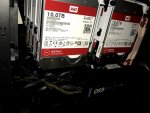Stevie_1der
Explorer
- Joined
- Feb 5, 2019
- Messages
- 80
Ok, so here my requirements list:
- Must have
- Redundant storage with suitable SMB read and write performance for GBit LAN.
- ECC RAM
- IPMI (without additional license fees like for example some HP servers)
- Compact and quiet build with front accessible hot swap bays.
Something the size of a Norco ITX-S8, Ablecom CS-T80 (both unavailable) or Silverstone DS380 (has some serious HDD cooling issues, and cheap-looking drive trays without individual LEDs) would be ideal.
Six 3.5" bays would be sufficient for RAIDZ2, but I didn't find any chassis that size.
So I came up with four bays with RAIDZ1, with chassis like SuperMicro 721TQ, or Inter-Tech IPC SC-4100 / Norco ITX-S4 (those two look exactly the same).
From all these chassis, the SuperMicro 721TQ and the Ablecom CS-T80 seem best quality-wise.
Why is that eight-bay-stuff so darn rare...?
I'd actually prefer 8 bays to 4 bays, if only a decent chassis were available.
- Should have
- Upgradeable CPU
- Front door
- Nice to have
- An additional 2.5" hot swap bay, or a 3.5" or slim ODD bay where I could fit a hot swap bay for the boot SSD.
- Maybe Plex jail with hardware transcoding support (if that feature becomes available)
- Don't care to have
- 10GBit LAN
- Powerful virtualisation capabilities
- Database server
- Domain controller, mail server, OwnCloud etc.
- Must not have (new point from me)
- 19" rack mount chassis or huge full size tower.
In the worst case, instead of buying one of those, I'd rather populate my old Sharkoon Rebel9 with some 5.25" to 3.5" hot swap backplanes...
- 19" rack mount chassis or huge full size tower.
- Files that are easily replaceable, or lack of replacement would be a minor inconvenience at worst
~1.5TB - Files that are not as easy to replace but not critical - losing them would be a large inconvenience but not the end of the world
~1TB, plus Windows Backups for 2 PCs - Files that are irreplaceable
~0.2TB

